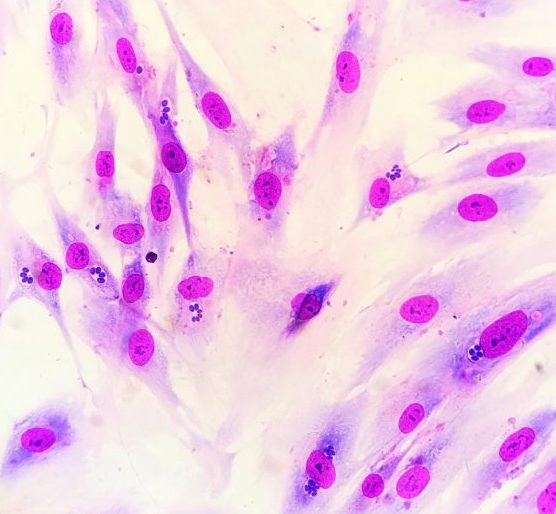Introduction to Pyrimethamine

Pyrimethamine is known chemically as 5-(4- chlorophenyl)-6-ethyl-2, 4-pyrimidinediamine and has the molecular formula of C12H13ClN4. It is an antiparasitic drug mainly used to prevent and treat Malaria and Toxoplasmosis and is classified as a dihydrofolate reductase (DHFR) inhibitor. [2]
It is commonly used with a sulfonamide and treats protozoan infections by blocking nuclear acid synthesis, therefore disenabling DNA replication and cell division. Although mammalian cells also undergo nucleic acid synthesis, Pyrimethamine is highly selective towards plasmodium as the DHFR of mammalian cells is less sensitive to the drug, making it suitable for clinical use. [1]
Toxoplasmosis
Toxoplasmosis is a disease that is caused by the single-celled eukaryotic protist Toxoplasma gondii, a plasmodium which is estimated to have infected 1 out of 3 of the world's population. In some populations, the percentage of people infected is up to 90%. Most cases of a T. gondii infection are harmless in immunocompetent individuals but can lead to toxoplasmosis in immunosuppressed individuals. [5]

Toxoplasmosis is a food-borne disease, often caused by the consumption of food contaminated with oocysts or bradyzoites of T.gondii. It may also be transmitted congenitally, and uncommonly through blood transfusion, transplantation, and through breast milk. [4] Symptoms of toxoplasmosis may range from headaches, fevers, muscle aches and fatigue, to inflammation of the lungs, heart, or eyes (ocular toxoplasmosis). Occasionally, it can also lead to death. [6] T. gondii infections can be passed to a fetus from the mother and can increase the risk of birth defects and miscarriages.
Humans are intermediate hosts of the parasite, while members of the Felidae family are definitive hosts. Thus, oocysts are excreted in cat faeces and can then contaminate food and water sources, and infect warm-blooded animals when consumed. The oocysts can survive in the environment for up to 18 months but can stay within a host for possibly a lifetime. [5]
Treatment of toxoplasmosis targets the protein dihydrofolate reductase (DHFR), which is an enzyme involved in folate synthesis in T. gondii cells. Folates are a type of micronutrient that functions as a co-factor in reactions to synthesis nucleotides and amino acids and are synthesised in prokaryotes. [8] When folate synthesis is inhibited, T. gondii cells can no longer replicate DNA to grow or reproduce, and therefore DHFR inhibitors are promising for new therapeutic design. Pyrimethamine is an antifolate and a competitive inhibitor of DHFR, and specifically results in the inability to synthesis the nucleotide base thymine as it forms a complex with the bifunctional dihydrofolate reductase thymidylate synthase. Therefore, this research aims to study the structure if pyrimethamine and its complex with DHFR-TS to investigate its molecular interactions and pathways.
Drawbacks and Limitations
Pyrimethamine is usually given as a single-dose treatment for toxoplasmosis as the drug is absorbed and eliminated over a few days. It is often given with the sulfonamide sulfadoxine as sulfadoxine-pyrimethamine (SP) as both drugs interfere with 2 consecutive steps of the synthesis of folic acid in parasites and therefore increase the effectiveness of treatment. However, no current medication completely eradicates T. gondii from the body as pyrimethamine does not affect T. gondii cysts in the body. Apart from its antiparasitic properties, pyrimethamine has recently been considered an investigational anticancer drug. [7]
Pyrimethamine itself is a relatively safe drug, rarely causing allergic reactions as pyrimethamine is significantly more selective for the T. gondii cells than mammalian cells. [3] Some patients may experience anorexia and vomiting [1], though patients with a history of folate deficiency may experience megaloblastic anaemia, neutropenia, or thrombocytopenia. When administered as SP adverse reactions stem from the sulfonamide part of SP, and in severe cases can affect gastrointestinal toxicity, cutaneous toxicity, the central nervous system, the renal system, and haematological toxicity. [2]
References
- DARAPRIM. PRESCRIBING INFORMATION, 1992. https://www.accessdata.fda.gov/drugsatfda_docs/label/2017/008578s020lbl.pdf.
- White, Nicholas J. “Malaria.” In Elsevier eBooks, 569–617, 2024. https://doi.org/10.1016/b978-0-7020-7959-7.00049-x.
- Rifkind, David, and Geraldine L. Freeman. “CHEMOTHERAPEUTIC AGENTS.” In Elsevier eBooks, 51–54, 2005. https://doi.org/10.1016/b978-012369353-2/50012-6.
- Fernández, Carolina, Jesús Jaimes, María Camila Ortiz, and Juan David Ramírez. “Host and Toxoplasma gondii genetic and non-genetic factors influencing the development of ocular toxoplasmosis: A systematic review.” Infection Genetics and Evolution 44 (October 1, 2016): 199–209. https://doi.org/10.1016/j.meegid.2016.06.053.
- Yu, Chia-Peng, Bao-Chung Chen, Yu-Ching Chou, Chi-Jeng Hsieh, and Fu-Huang Lin. “The Epidemiology of Patients with Toxoplasmosis and Its Associated Risk Factors in Taiwan during the 2007–2020 Period.” PLoS ONE 18, no. 8 (August 25, 2023): e0290769. https://doi.org/10.1371/journal.pone.0290769.
- Department of Health & Human Services. “Toxoplasmosis.” Better Health Channel, n.d. https://www.betterhealth.vic.gov.au/health/conditionsandtreatments/toxoplasmosis#symptoms-of-toxoplasmosis.
- Manoharan, Sivananthan, and Lee Ying Ying. “Pyrimethamine Reduced Tumour Growth in Pre-Clinical Cancer Models: A Systematic Review to Identify Potential Pre-Clinical Studies for Subsequent Human Clinical Trials.” Biology Methods and Protocols 9, no. 1 (January 1, 2024). https://doi.org/10.1093/biomethods/bpae021.
- Revuelta, José Luis, Cristina Serrano-Amatriain, Rodrigo Ledesma-Amaro, and Alberto Jiménez. “Formation of Folates by Microorganisms: Towards the Biotechnological Production of This Vitamin.” Applied microbiology and biotechnology, October 2018. https://www.ncbi.nlm.nih.gov/pmc/articles/PMC6153639/.